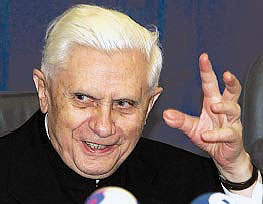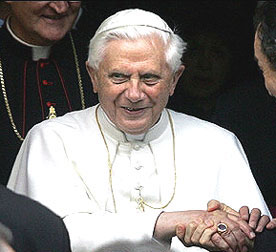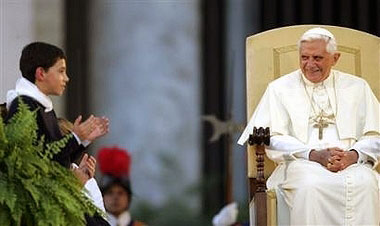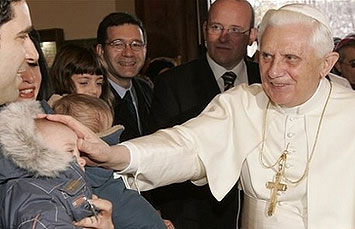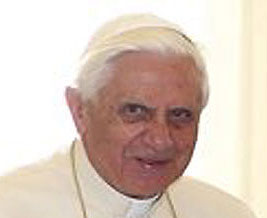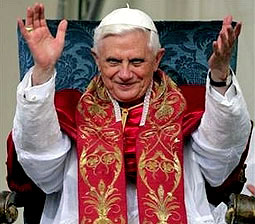|

by Jay Nelson
from
RenegadeCatholic Website
|
Ratzinger helped
accidentally start them.
He's already ended them, too. |
Shocking as these statements may be,
there is a clear chain of evidence that backs them up. Pope Benedict
XVI, Joseph Ratzinger, bears a unique personal responsibility
for the entire mess.

Moreover, his responsibility has nothing at all to do with his
current position as Supreme Pontiff.
His actions forty years ago
helped set the stage of the crisis in the first place. And it was
his efforts to begin to undo the effects of those actions twenty
years later that will inevitably cause the scandals to end.
Outrageous? Impossible? Crazy?
Consider the following historical items
and connect the dots yourself. It all hinges on the fact that the
Inquisition (now called the "Congregation for the Doctrine of the
Faith" or CDF) has been running the cover-up since the
counter-Reformation a fact that has recently been acknowledged by
a leading expert,
Tom Doyle.
If you wish more detail on how the cover-up worked and why it
failed, much more will be forthcoming in a book soon.
A Brief
Timeline
Before the Scandals
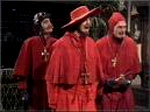
"No one expects the
Spanish Inquisition!"
There were few clergy abuse scandals for hundreds of years simply
because clergy sexual abuse was covered up at first by the
Inquisition and later by the secret system it had created.
-
1478 The Spanish Inquisition is
founded by Ferdinand and Isabella. Run and jealously guarded by
the crown, its prime focus is mainly on protecting the state
from divisions caused by converted Jews and Moslems, as well as
heresy and clergy misconduct.
-
1542 The Roman Inquisition is
revived by Pope Paul III in the wake of the Protestant
Reformation. From the beginning, the Roman version is mainly
concerned with intellectual dangers to the Church at large, such
as Lutheranism and modern science as well as clerical
discipline. It publishes the Index of Forbidden Books, and
remains to this day (although under a different name) as it
began: the most powerful department of the Vatican.
-
1559 Pope Pius IV authorizes the
Spanish Inquisition to actively seek out and punish priests who
seduce women through misuse of the sacrament of Confession,
known as "solicitation in the confessional."
-
April 15, 1561 The pope, pleased
by its success, extends its sexual jurisdiction over all Spanish
dominions. The recently revived papally-run Roman Inquisition is
given similar broad powers.
The crime of solicition is first published as one that must be
denounced to the Inquisition under penalty of excommunication.
This causes such a sensation in Spain that the scribes are
overwhelmed by the number of women complaining. It would be
quietly removed from the list, even while later popes extended
the powers and jurisdiction of the Inquisition over clergy sex
cases.
Around 1565, the confessional booth is invented in Milan by St.
Charles Borromeo, as a screen between two chairs. The idea is to
prevent sexual contact between priests and penitents. Within
half a century, the Vatican would order them installed in every
church in the world.
-
1622 Pope Gregory XV decrees that
priests are still obliged to individually inform pentitents of
their duty to inform on sexually predatory clergy, but the whole
process becomes cloaked in secrecy. In areas where no
Inquisition is active, bishops are empowered to set up their own
secret tribunals and inflict the most extreme punishments.
-
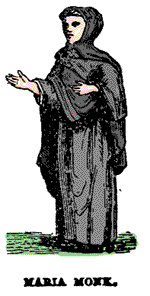 1646
The Piarists, a highly successful order teaching poor boys
across Italy, is abolished by the pope for child sexual abuse.
Founded by the patron saint of Catholic education, St. José
Calasanz, the order had been taken over by a pedophile ring, and
finally busted by the Roman Inquisition. The order will be
quietly revived later, but these scandals are successfully
concealed until the opening of the Inquistion's own archives at
the dawn of the twenty-first century. 1646
The Piarists, a highly successful order teaching poor boys
across Italy, is abolished by the pope for child sexual abuse.
Founded by the patron saint of Catholic education, St. José
Calasanz, the order had been taken over by a pedophile ring, and
finally busted by the Roman Inquisition. The order will be
quietly revived later, but these scandals are successfully
concealed until the opening of the Inquistion's own archives at
the dawn of the twenty-first century.
-
1820 The Spanish Inquisition is
abolished by decree. Archives show its continual intervention in
clergy sex cases until the very end.
-
1836 "Maria
Monk," an alleged escapee from a Canadian convent, is
the first to break silence about sexual and other abuse in
nunneries. She is nearly universally reviled and disbelieved.
-
1867 American historian
Henry Charles Lea publishes a
three-volume study on celibacy in the Catholic Church which
reveals the long and often futile struggle to impose chastity on
clerics, including the involvement of the Inquistion, and is
largely ignored.
-
1880 Personal friend of Lincoln
and former American priest,
Charles Chiniquy, bitterly
complains of the current ongoing dangers and results of
solicitation in The Priest, The Woman, and the Confessional.
-
1908 The now-Universal Roman
Inquisition is renamed the "Supreme Sacred Congregation of the
Holy Office" and given authority across the globe.
-
1922 Any knowledge at all of the
Holy Office's role in sex crimes is now deemed too scandalous.
New rules were written. They have never been released.
-
1947 The Servants of the Paraclete,
a religious order dedicated to helping fallen priests, is
established with headquarters in Jemez Springs, New Mexico by
Fr. Gerald Fitzgerald.
-
1954 An American ex-Franciscan,
Emmett McGloughlin, in his autobiography first reveals the
existence of the Jemez Springs establishment as one
"ecclesiastic prison" among others where priests are sent
without trial for sexual offenses, alcoholism, and
insubordination.
-
1962 Reporting laws that mandate
disclosure of sex abuse appear for the first time and
McGloughlin publishes another book with a few more details on
Jemez Springs. Prophetically, he writes, "The sexual affairs of
priests in the U.S. are more closely guarded secrets than the
classified details of our national defense."
-
On March 16, Cardinal Alberto
Ottaviani, the head of the Holy Office, presents Pope John XXIII
with Crimen sollicitationis, in English,
Instruction on
the Manner of Proceeding in Cases of Solicitation. This is a
highly secret document containing instructions for bishops on
how to proceed trying cases of sexual abuse and homosexuality
among clerics.
-
In October, the Second Vatican
Council begins.
Vatican II...
The secret system was inadvertently
broken during the Ecumenical Council.
Though it happened as an unintended
consequence of trying to protect progressive theologians, Joseph
Ratzinger was undoubtedly largely responsible for this.
-
 Immediately
after the Council began, the head of the liberal faction,
Cardinal Josef Frings of Belguim, opposes Ottaviani's proposed
plan of discussion. Ottaviani boycotts the Council for weeks out
of pique, giving liberals the chance to determine their own
agenda. Among them is Joseph Ratzinger, one of Frings' trusted
theological advisors. Immediately
after the Council began, the head of the liberal faction,
Cardinal Josef Frings of Belguim, opposes Ottaviani's proposed
plan of discussion. Ottaviani boycotts the Council for weeks out
of pique, giving liberals the chance to determine their own
agenda. Among them is Joseph Ratzinger, one of Frings' trusted
theological advisors.
-
On November 8, 1963, Frings gives a
rousing speech that Ratzinger wrote calling for reform of the
Holy Office and its "medieval ways." It is enthusiastically
applauded. Pope Paul VI calls Frings that evening to tell him
that the reform will go through.
-
Heated discussions over celibacy and
the clergy also consume the Council. Finally in the Decree on
the Life and Ministry of Priests, carefully coded language
reveals that 1) priests will no longer be punished for sexual
transgressions but treated with "with fraternal charity and
magnanimity" and 2) celibacy is not necessary for the priesthood
but would still be demanded of Latin-rite priests. This sets the
stage for the great clergy exodus.
-
On December 7, 1965, the very last
day of the Council, the reform of the Holy Office is announced.
It will henceforth be called the "Congregation for the Doctrine
of the Faith" (CDF). Some secrecy will be ended, priests would
be given certain rights of appeal and representation, and the
Index of Forbidden Books will be discontinued. Ominously, the
CDF is given the power of questioning faith and morals anywhere
in the entire Church. Only the Pope retains more power.
... and After
It took some time for the "secret
system" to break down after Vatican II. It took just as long for
Cardinal Ratzinger to fix it.
-
June 14, 1967 Finally bowing to
pressure, Pope Paul IV issues an encyclical that removes the
restrictions of the Holy Office on clergy wishing to leave, and
the flight of disgruntled religious begins.
-
1968 Returning to academic life,
Ratzinger is traumatized by anticlerical student protesters. His
doubts about the direction of the Council grow, and he becomes a
reactionary.
-
Mid-1970s With few other options
available, the Paracletes' Jemez monastery becomes a major
center for treating priests with sexual problems, over the
objections of founder Fitzgerald, who wanted to imprison them on
an island for life. Instead, the order opens up more treatment
centers, even halfway houses, and loans priests in treatment out
to local communities without warning anyone. At some point, they
are advised to destroy most of their files by the bishops, and
advised the New Mexico archdiocese to do the same.
-
1981 Pope John Paul II names
Ratzinger as Prefect of the CDF. The former protestor is now the
"Vatican's enforcer." He begins a highly publicized series of
campaigns against liberal causes that have sprung up since the
Council and many of his former allies, too, such as Hans Kung
and Karl Rahner. National bishops councils established by the
Council are also opposed as threats to papal power.
-
1983 Canon Law (pdf)
is revised, complete with a statute of limitations for clergy
sex crimes.
-
1984 The first significant modern
scandal begins with the exposure of Gilbert Gauthe, a serial
child molester in Louisiana. His attorney, Ray Mouton, calls for
help. Priests Tom Doyle, then working in the nunciature in
Washington, and Michael Peterson, a psychiatrist who had
recently founded a treatment center for troubled priests, become
involved. Together, they write a proposal for American bishops,
The Problem of Sexual Molestation by Roman Catholic Clergy:
Meeting the Problem in a Responsible Manner, most simply known
as The Manual (link).
It calls for a "crisis control team" to fly around the country
putting out hotspots, with little concern for victims.
-
1985 The Manual is presented to
the bishops at their June meeting. It would even be shown to
Pope John Paul II. Nothing happens.
-
1992 The scandals first receive
extensive national media attention when the notorious James
Porter cases surface. His tracks lead to Jemez Springs, which
leads to scandals breaking out in New Mexico. By this time, some
1,200 other religious had also passed through their programs.
American bishops find themselves again frustrated by Rome, which
blocks their proposals.
-
1993 Archbishop Robert Sanchez of
New Mexico becomes the first high-ranking prelate to fall as his
affairs are exposed on CBS' 60 Minutes.
-
 At
World Youth Day in Denver, Pope John Paul II infamously
dismisses the crisis as a largely North American affair due to a
corrupt secular society. At
World Youth Day in Denver, Pope John Paul II infamously
dismisses the crisis as a largely North American affair due to a
corrupt secular society.
-
Late 1990s Despite the pope's
wishful thinking, the crisis becomes truly global. Scandals
continue throughout the United States, too many to mention, but
also break out across Canada, Ireland, Australia, Austria, even
Poland.
-
The Servants of the Paraclete scale
back their treatment progams in New Mexico. Meanwhile, two
priests, a former client and one of their own, are murdered in
separate events by men claiming they were abused by them.
-
1997 Ratzinger opens the
Inquisition's own secret archives to select scholars, allowing
for the rediscovery of the Inquisition's role in the cover-up.
-
April 30, 2001 The CDF secretly
issues Sacramentorum sanctitatis tutela, or Safeguarding
the Sanctity of the Sacraments (link)
under Pope John Paul II's name. This replaces Crimen
sollicitationis with a policy even more secret and ruthless
than before. All priestly sex crimes are to be placed under the
CDF, which usually will authorize the bishops to conduct trials
themselves. However, clerical homosexuality is not even
mentioned.
-
May 18, 2001 Ratzinger quietly
adds the cover letter (pdf)
for the new policy, making cases "subject to the pontifical
secret." In other words, absolute secrecy is imposed on all who
know about them under pain of automatic excommunication that
only the pope can forgive.
-
2002 American bishops issue the
so-called "Dallas Charter" calling for audits and zero
tolerance.
-
 2002
The scandals reach Boston (again) with John Geoghan and other
cases. Cardinal Bernard Law, exposed as a prime enabler of the
cover-up, resigns and is compensated with a major post in the
Vatican. 2002
The scandals reach Boston (again) with John Geoghan and other
cases. Cardinal Bernard Law, exposed as a prime enabler of the
cover-up, resigns and is compensated with a major post in the
Vatican.
-
2003
Crimen sollicitationis is
discovered among diocesan legal papers in Boston.
-
2004 Pope John Paul II apologizes
for the excesses of the Inquisition and asks for forgiveness.
-
The National Review Board issues a
report claiming 10,000 child sexual abuse victims of nearly
4,000 Catholic priests just in the United States over the last
50 years, undoubtedly gravely underestimated.
-
April 19, 2005 Ratzinger ascends
the papal throne as Benedict XVI.
-
In June, the US Conference of
Catholic Bishops finally gets a toothless version of the Charter
for the Protection of Children and Young People approved.
-
2007 David Yallop, in his
critical biography of John Paul II, reports that there are so
many referrals for action against priests to the CDF that it
takes 18 months just to get a reply.
-
2008 The Vatican reports that for
the third year in a row, the number of new cases has gone
steadily down, despite record high financial settlements.
Note: more money, but fewer
cases, and many more priests being reported to Rome.
This is exactly
what should be expected if the secret system is once more in place.
And Joseph Ratzinger, who helped accidentally dislodge it, is
the one largely responsible for doing so.
One can only shudder at what he may accomplish as pope.
The Roman Catholic Church, it seems, is quietly once again
dispensing its "justice" privately, unobserved and therefore
unchecked and unbalanced. Once again, it asserts its clerical
"privileges" that is to say, private laws for the good of the
clerical class, not the secular society. And certainly not for the
boys and girls, women and men, who are have been or will be, its
victims.
Is this at all tolerable in a modern democratic society that upholds
one law for all people?
More than anything else and there are plenty of other good
reasons, too that is why this ecclesiastical tyrant must be
opposed.
BOYCOTT BENEDICT!!
Pope Benedict XVI is on his way to Australia for
World Youth Day, July 20, 2008.
His first visit Down Under promises to be quite the event, full of
pontifical pomp, with hundreds of thousands of enthusiastic Catholic
adolescents hanging on his every word.
Yes, quite a busy week for His Holiness, to be sure.
But apart from wearing the nice white suit, does this man really
deserve this attention?
If only the kids knew that the sex scandals that have rocked their
country and much of the rest of the world are in some small part due
to him. And that's just one of the many reasons. Thus, the
BOYCOTT BENEDICT campaign.
Reasons
Before he became Pope, Cardinal
Joseph Ratzinger served as the Prefect of the Congregation
for the Doctrine of the Faith (CDF), which at one time
had been called the Holy Office of the Universal Roman
Inquisition. Yes,
that Inquisition.
The one that
silenced Galileo and burnt Bruno. It was also the one that kept the
lid on clergy sexual abuse for over 400 years.
As head of the CDF, Ratzinger deliberately cranked the clock back to
the Middle Ages. Or at least long before the Second Vatican Council.
He personally helped squash most of the progressive hopes that he
himself had promoted during the Council. It reads like a litany of
the damned.
Among them are:
-
Liberation theology, taking the
"preferential option for the poor" of the Gospel seriously, was
condemned. Along the way, so too were his old friends and allies
from the Council, including Leonardo Boff, Hans Kung, and Karl
Rahner.
-
Women's ordination hopes were dashed
by raising the doctrine of verismilitude that possession of a
penis like Jesus, even if unused, was somehow vitally important
to the office of priest to near-dogmatic status.
-
Gays were denied any participation
unless totally celibate. Quite a bit of hypocrisy there as many
experts reckon that well over half of the clergy itself is
homosexual, and most of them are active.
-
Ecumenical flowerings withered on
the vine by suggesting that any Christian denomination denying
the pope were somehow lacking. It is, by the way, now an offense
worthy of automatic excommunication and a secret trial for any
priest who participates in a Mass with non-Roman Catholics on
the same level as a Black Mass or sexual abuse.
-
Inter-religious relations haven't
flourished either, especially with the Muslims, whom Benedict
managed to insult by calling Muhammad an evildoer. Nor have the
Jews been pleased by his promotion of the idea that Catholics
continue to pray for their conversion.
And the main reason:
Not only that, he is simply one
evil-looking dude.
The Campaign
To join the campaign is simple:
-
Don't participate in any papal
events.
-
Don't contribute to any special
papal monetary collections including the Peter's Pence
drive.
-
Do something pleasant instead.
-
Do show your feelings!
One Scary Pontiff
A Gallery of Pictures of Pope
Benedict XVI
Would you buy a used religion from this
man?
Yes, anyone can have a bad hair
day. Anyone can have fun with a silly hat.
 
 But
how is that someone who is supposed to be the representative of God
on Earth can look so consistently evil? But
how is that someone who is supposed to be the representative of God
on Earth can look so consistently evil?
True story: the day Joseph Ratzinger was elected Pope, someone
replaced his picture on his page at Wikipedia with this one of
Senator Palpatine from Star Wars.
It went unnoticed for some time. It's an
appropriate comparison, seeing as both started off as champions of
the underdog and became spooky-looking, power-mad tyrants.
And indeed, the graphic comparison to
the evil Emperor is uncomfortably apt.
Of course, it's easy to exaggerate the look with Photoshop...
But below are a series of photos of Benedict collected from the
Internet. Judge for yourselves if they are fake or real.
|
 |
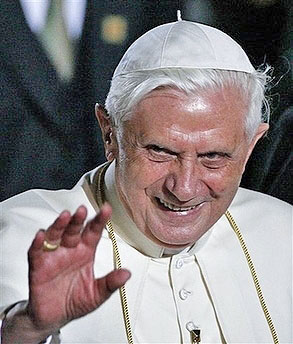
Such a
charming smile, and so humble too... |
|
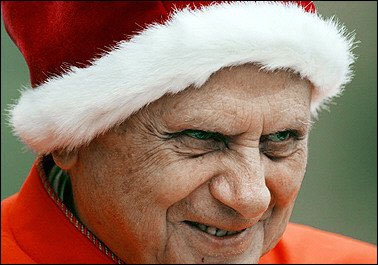
No, it's not
"Evil Santa"... |
 |
|
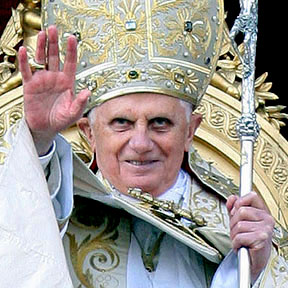 |
 |
It's good to be the Pope.
He certainly has fun with the job, loves
waving at the crowds, and displaying himself for their adulation.
If he just didn't look so creepy...
|
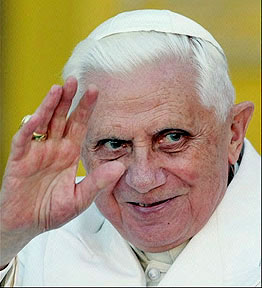 |
 |
|
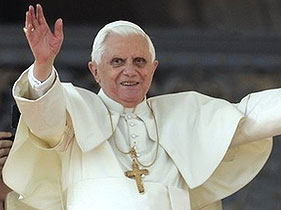 |
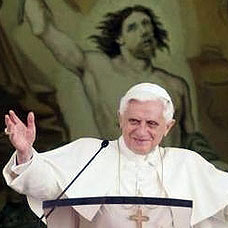 |
|
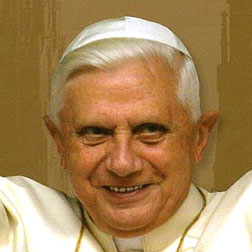 |
 |
|

Here's an
interesting sequence. Enjoying the crowd's worship
during a visit to his old stomping grounds in Munich,
Benedict looks both happier and nastier by the second. |
 |
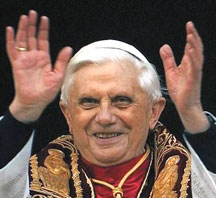 
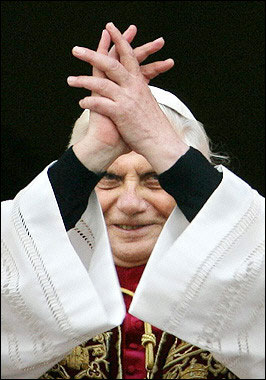
"Ego sum papa."
I'm surprised the kids aren't crying....
"Trust me! I'm the Pope!"
|



 1646
The Piarists, a highly successful order teaching poor boys
across Italy, is abolished by the pope for child sexual abuse.
Founded by the patron saint of Catholic education, St. José
Calasanz, the order had been taken over by a pedophile ring, and
finally busted by the Roman Inquisition. The order will be
quietly revived later, but these scandals are successfully
concealed until the opening of the Inquistion's own archives at
the dawn of the twenty-first century.
1646
The Piarists, a highly successful order teaching poor boys
across Italy, is abolished by the pope for child sexual abuse.
Founded by the patron saint of Catholic education, St. José
Calasanz, the order had been taken over by a pedophile ring, and
finally busted by the Roman Inquisition. The order will be
quietly revived later, but these scandals are successfully
concealed until the opening of the Inquistion's own archives at
the dawn of the twenty-first century.  Immediately
after the Council began, the head of the liberal faction,
Cardinal Josef Frings of Belguim, opposes Ottaviani's proposed
plan of discussion. Ottaviani boycotts the Council for weeks out
of pique, giving liberals the chance to determine their own
agenda. Among them is Joseph Ratzinger, one of Frings' trusted
theological advisors.
Immediately
after the Council began, the head of the liberal faction,
Cardinal Josef Frings of Belguim, opposes Ottaviani's proposed
plan of discussion. Ottaviani boycotts the Council for weeks out
of pique, giving liberals the chance to determine their own
agenda. Among them is Joseph Ratzinger, one of Frings' trusted
theological advisors.  At
World Youth Day in Denver, Pope John Paul II infamously
dismisses the crisis as a largely North American affair due to a
corrupt secular society.
At
World Youth Day in Denver, Pope John Paul II infamously
dismisses the crisis as a largely North American affair due to a
corrupt secular society.  2002
The scandals reach Boston (again) with John Geoghan and other
cases. Cardinal Bernard Law, exposed as a prime enabler of the
cover-up, resigns and is compensated with a major post in the
Vatican.
2002
The scandals reach Boston (again) with John Geoghan and other
cases. Cardinal Bernard Law, exposed as a prime enabler of the
cover-up, resigns and is compensated with a major post in the
Vatican. 

 But
how is that someone who is supposed to be the representative of God
on Earth can look so consistently evil?
But
how is that someone who is supposed to be the representative of God
on Earth can look so consistently evil?



















